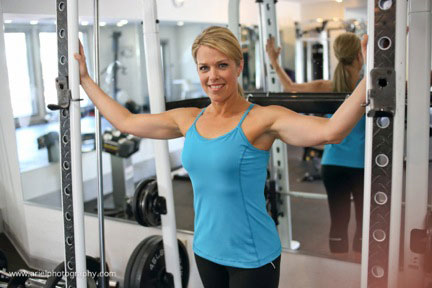
How This Trainer Helped Her Sister Lose 16 Pounds—And Keep It Off
Client: Maureen
Personal Trainer: Maryalice Goldsmith, owner and founder, InsideOut Wellness
Location: Princeton, New Jersey
Time for change.
In January 2013, Maureen decided it was time to make a change. Her sister, Maryalice Goldsmith, personal trainer and owner of InsideOut Wellness, an online coaching company, says, “I remember sitting around Maureen’s kitchen island after our New Year’s Eve festivities when Maureen said, ‘This is it—I am so done with this extra weight. I am climbing out of the valley!’”
Maureen had always been active, but as time passed and menopause approached, her weight crept up. She routinely felt bloated and struggled with her energy levels.
“Maureen wasn’t sure what her body needed the most and where to begin,” Goldsmith says. “I think many women are like that; they want [change], but
how
to do it is the issue. My sister was always thin, so this was a first in terms of consciously having to lose weight.” Goldsmith was eager to help.
Food focus.
The first step was to determine if certain foods known to be problematic for some people were reacting negatively with Maureen’s changing body chemistry. The trainer eliminated dairy, alcohol, sugar and some processed foods from her client’s diet for 4 weeks and then slowly reintroduced them, one by one, searching for clues like gas, bloating and constipation.
“For example, when Maureen tried to eat cottage cheese she quickly realized this did not sit well with her digestive system,” recalls Goldsmith. “She assessed that dairy was an issue.”
Goldsmith encouraged her client to remove all dairy from her diet, except for raw, organic cheese.
Realistic eating.
Aside from an initial assessment to determine negative food reactions, Goldsmith advocates a flexible approach to eating. “I want my [clients] to create a lifestyle mindset,” she says. “For Maureen, after the first 4 weeks were completed we transitioned into creating a healthy lifestyle for her.” This meant that if Maureen opted for a glass of wine with dinner, she would skip the bread or keep dessert to only a few bites.
“All that ‘No,
can’t
have that!’ and ‘Nope,
can’t
drink that!’ catches up to you,” Goldsmith explains. “For my clients, it’s about ‘I
don’t
want that because I would rather have this tonight and maintain my healthy lifestyle.’”
Individualized exercise.
Goldsmith outlined a very specific plan for her sister that would help her achieve her goals. “I created a workout regime that split the training into upper- and lower-body exercises for the first 4 weeks.”
During each of those 30-minute sessions, Maureen used moderate resistance—lifting weights in specific sequences at a somewhat rapid pace. Goldsmith believes that using external resistance in this way is highly effective for burning fat and shaping the body. As Maureen grew stronger, she transitioned to full-body workouts.
Goldsmith also paid attention to stress levels, which can be more sensitive during menopause. “If [stress] is not managed properly, weight gain in the midsection and the hip and thigh area is imminent,” she warns.
To counteract daily stresses, the trainer encouraged her client to walk as much as possible—ideally directly after the workout. “This is not speed walking with ankle weights and 3-pounders in your hand; this is a restorative walk,” Goldsmith advises. “It’s about calming things down, not revving things up,” she says.
Knowing your body.
“I followed the program and dutifully maintained 90% compliance,” says Maureen. “I went from 149 pounds and 31% body fat to 133 pounds and 24% body fat. I can now reach into the far corner of my closet and pull out pants I haven’t worn in 2 years. This is the
best
part.”
Goldsmith emphasizes that her sister’s success is rooted in the mind. “Maureen, 2 years later, maintains her health and fitness,” Goldsmith remarks. “She has embraced the lifestyle 100%. She knows exactly what her body needs and how to provide it. This is the only way to experience long-term health—knowledge of your very own body. Diets and meal and workout plans are all temporary fixes without long-term education about what your individual body needs.”